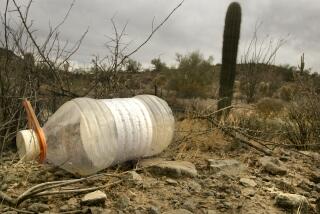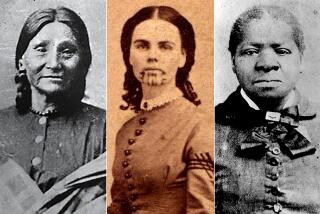The lasting pull of the Donner saga
- Share via
Searching for
Tamsen Donner
Gabrielle Burton
University of Nebraska Press: 328 pp., $26.95
--
It’s little wonder that some people remain obsessed by the story of the Donner Party. We all know the basic outline: An emigrant wagon train of 90 people headed for California starts west out of Illinois and Missouri in the spring of 1846. By the time the wagons and the walkers hit the eastern edge of the Sierra months later, they’ve already been cursed by bad luck, bad leadership and bad advice.
Then the snowstorms wallop them. Exhausted, frozen and hungry, the emigrants begin to die. Nearly half of the 90 perish, and some of the living eat the flesh of the dead.
There’s nothing like this in the history of the American frontier. The saga begins in the innocence of a Midwestern spring, is punctuated by dramatic episodes across the prairies and crescendos to terror at its wintry conclusion the following year. The Donner Party is a Hitchcock film of westward expansion.
And it’s true. Or at least much of it is, complete with memorable dialogue worthy of any screenplay. “Are you men from California, or do you come from Heaven?” one Donner Party woman asks her would-be rescuers, only to die shortly thereafter.
Gabrielle Burton is among the obsessed. Her particular fascination is for Tamsen Donner, the estimable wife of George Donner, who would become (fated) captain of the emigrant train while on the journey. Presumed to have died with the others, her husband included, Tamsen’s body and exact fate have never been discovered. Neither has the diary or journal she was known to have kept on the trail.
“Searching for Tamsen Donner” is a kind of eulogy, one that recounts a trip Burton took in the late 1970s with her husband and five young daughters. An unusual variant of the “on the road” idea, the journey retraced the route the Donner Party took toward its fateful rendezvous with snow and death. Burton wanted to use the trip to research a work of fiction; those plans never came to pass. Instead, all these years hence, we have this odd, unlikely book. History lesson, memoir and intimate family portrait all at once, “Searching for Tamsen Donner” simultaneously re-creates the 1840s and the 1970s, east to west.
Burton certainly knows her subject. It’s hard not to share in her single-minded exhilaration as she cajoles and essentially drags her family westward, from monument to monument, all in a hunt for faded markers or the merest hints that might suggest “the Donner Party slept here.”
And yet, for all that is clearly thrilling, walking in the footsteps of the Donner Party isn’t quite enough. Burton wants to cajole the emigrants too. Given the chance to go back in time, she’d scold the Donner Party members she knows so well: “Hurry up!” “Move faster!”
Who could blame her? Emigrants did dawdle, especially in the years before the Gold Rush, when what awaited them at trail’s end wasn’t all that different from what they’d left behind in the Midwest and elsewhere: the hard life of an antebellum American farm family.
Overlanders had never seen anything like the Great Plains; they’d never seen Rocky Mountain vistas, to say nothing of Native Americans and bison. They picnicked. They painted. They shot their guns off. They wandered around.
Most of the time, it wasn’t dawdling that killed them. Disease carried away most of those who died going west, and it did so largely in the early stages of the long journey, when it could catch the young, the old or the weak.
Many emigrants also drowned: 19th century Americans didn’t know how to swim. On the trails west, they constantly tumbled into creeks, rivers and lakes, and a surprising number of them stayed in.
George and Tamsen Donner, and those who went west with them, paid an unusually high price for bad luck and westerly leisure. They were also victimized by a faulty guidebook that told them how to get out of the Great Basin. The group followed the lead of a writer named Lansford Hastings, who proposed a remarkably difficult passage through the Wasatch Mountains. This “cutoff,” meant to lessen the time to California, ended up doing the opposite. All as snow clouds formed.
As the group -- already fractured by strife within its ranks -- began to climb the eastern edge of the Sierra Nevada in the winter of 1846, the snow began to fall. And fall. And fall. The Donner Party got stuck, many of them died and a piece of American history was born.
Burton notes the trials of the Donner Party with understandable pathos. She especially grieves Tamsen, a woman whose intelligence comes forth as plainly as her hardscrabble courage. Indeed, this is very much a book about death. We read of gravestone after gravestone along the trail, each with its sad markings (and sad stories behind them) duly noted. And Burton astutely narrates the final, deadly weeks of the Donner Party’s cold horror.
Yet despite its single-minded focus on Tamsen, “Searching for Tamsen Donner” is tinged by nostalgia, if not redemption. As dramatic and tragic as the story of the Donner Party is, it shares space here with the tender reflections of a mother of five daughters -- daughters whose filial companionship on a summer road trip long ago bespoke a very different kind of family journey across the American West.
More to Read
Sign up for our Book Club newsletter
Get the latest news, events and more from the Los Angeles Times Book Club, and help us get L.A. reading and talking.
You may occasionally receive promotional content from the Los Angeles Times.







